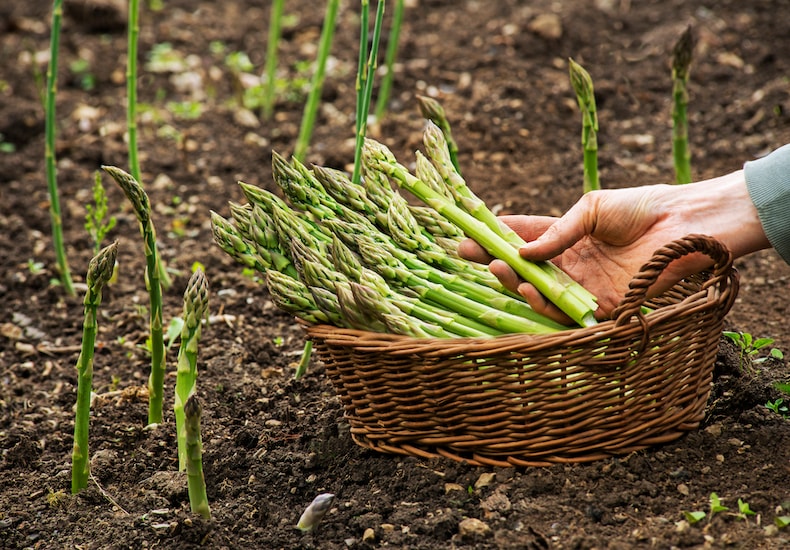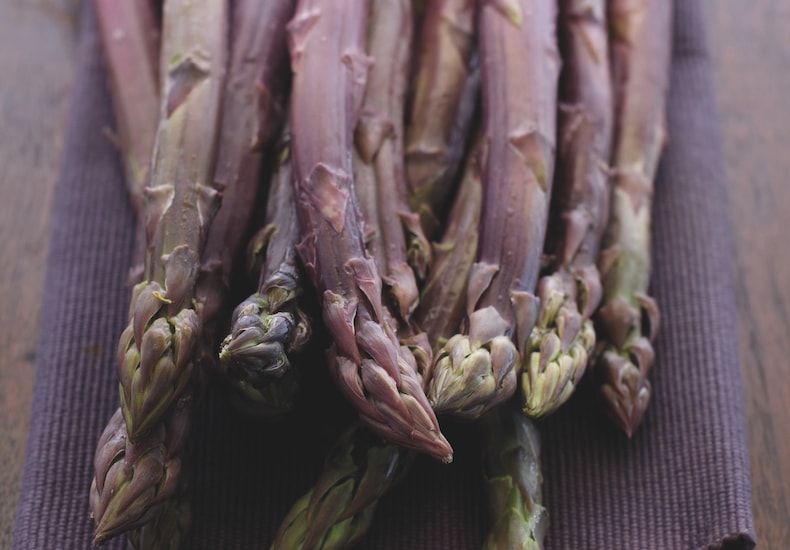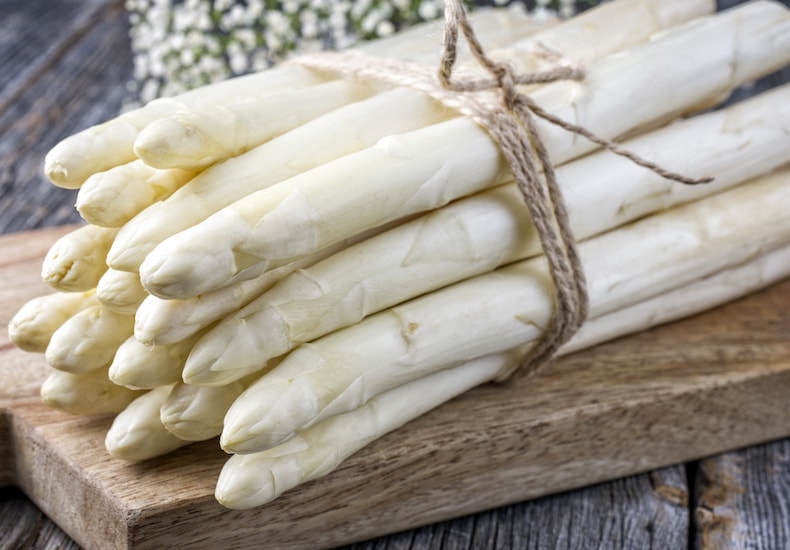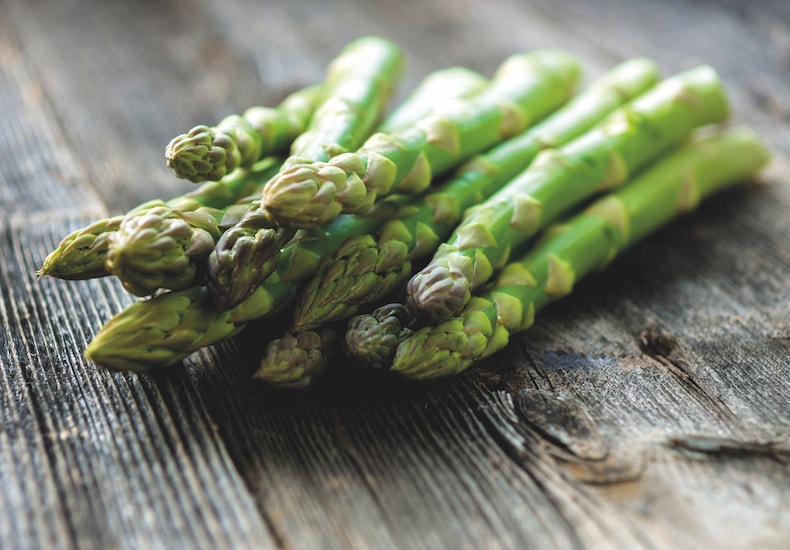
How to prune asparagus
Perennial vegetables like asparagus need to be correctly pruned if they are to deliver crops for up to twenty-five years. Here, T&M's horticultural team explains everything you need to know about cutting the edible spears and pruning the leafy asparagus ferns to ensure many years of healthy crops.
Take inspiration from our range of high quality asparagus crowns available for doorstep delivery.
Growing asparagus

Supplied as one year old crowns, asparagus 'Guelph Millennium' produces high yields
Image: Asparagus officinalis 'Guelph Millennium' (spring planting) from T&M
Before you start pruning your asparagus, it’s important to understand how it grows. The edible spears that we love to eat emerge from ‘crowns’ in the ground and, once your plants are established, these spears can be harvested for six to eight weeks each year.
At the end of the harvest season (in June) you’ll need to stop harvesting the spears to allow the tall ‘ferns’ to develop. This leafy foliage is how the plant gathers energy for next year’s crop. Eventually this fern-like foliage will die and need to be cut back, but not until it has done its job and the crown has become dormant.
When to prune asparagus ferns

Asparagus 'Burgundine' produces attractive purple spears
Image: Asparagus 'Burgundine' (spring planting) from T&M
Asparagus season is just two months long, from April to June. After midsummer's day, when you’ve stopped harvesting the spears, they’ll quickly start to grow into tall, leafy ferns. It’s important to let these grow, as they gather and return energy back down into the crown for the following year. The ferns will grow throughout the summer, reaching a bushy height of about 4 feet high.
At the end of autumn, the ferns will turn yellow or brown which is a good indication that they’re ready to be pruned. This job is best tackled in late winter (November or December) or early spring while the plants are dormant.
How to prune asparagus ferns

'Vittorio' is is a high-yielding variety that can produce both white and green spearss
Image: Asparagus 'Vittorio' (spring planting) from T&M
When pruning asparagus ferns, start by cutting them all back to a height of around 4-6 inches. Then remove all of the old, yellowing, brown and damaged foliage at the base of the plant. Next, cut back any spindly shoots that aren’t producing spears. Finally, gently rake the soil to remove all the debris. This helps to prevent disease and stops pests from overwintering in the bed.
Pruning newly planted asparagus

Asparagus 'Mondeo' provides impressive yields and high-quality spears
Image: Asparagus officinalis 'Mondeo' (spring planting) from T&M
Remember that newly planted asparagus crowns need time to get established, so the spears shouldn’t be harvested at all in the first two years. Let all the spears that emerge grow into ferns. Once the ferns turn brown, cut all the foliage down to 10 cm above the soil level and apply a thick layer of mulch.
When your plants are three years old, you can start harvesting some of the spears to eat. Remember to stop harvesting in mid-June and allow some stems to develop into ferns so the plant can build up energy reserves for the next year’s crop.
Pruning your asparagus helps to keep pests and diseases at bay, and makes weeding and mulching easier. But it's important to wait until your asparagus ferns have turned brown before you cut them down to the ground. Find everything you need to know about growing asparagus over on our helpful hub page.
See all pruning guides
Individual guides
Flower & Shrubs
- Pruning Buddleja
- Pruning Camellias
- Pruning Clematis
- Pruning Fuchsias
- Pruning Hydrangeas
- Pruning Hypercium - St Johns Wort
- Pruning Lavender
- Pruning Magnolias
- Pruning Passion Flowers
- Pruning Rhododendron
- Pruning Ribes Sanguineum
- Pruning Rosemary
- Pruning Roses
- Pruning Tree Peonies
- Pruning Wisteria
- Pruning Blueberries
- Pruning Goji Berries
- Pruning Honeyberries
- Pruning Raspberries
- Pruning Apple trees
- Pruning Box and Yew trees
- Pruning Catalpa trees
- Pruning Christmas trees
- Pruning Olive trees
- Pruning Patio Fruit trees
- Pruning Pear trees
- Pruning Plum trees
Fruit & Veg
Trees

Written by: Sophie Essex, garden writer
Sophie Essex is a freelance garden writer with a passion for horticulture and environmental conservation. With a BSc in Botany/Plant Biology from the University of Plymouth, she further honed her expertise through a Masters of Science in Biodiversity and Taxonomy of Plants from The University of Edinburgh. Sophie has also worked as a professional gardener and landscaper, showcasing her practical skills by transforming outdoor spaces. Her commitment to fieldwork is further evident in her acquisition of a Certificate in Field Botany from the Royal Botanic Garden Edinburgh, and over the years, she has interned at the Eden Project, Cornwall, the National Trust for Scotland and the Royal Botanic Garden Edinburgh.Banner image: Shutterstock
Sign Up For Exclusive Special Offers




© 2025 Thompson & Morgan. All rights reserved. A division of Branded Garden Products Limited.



